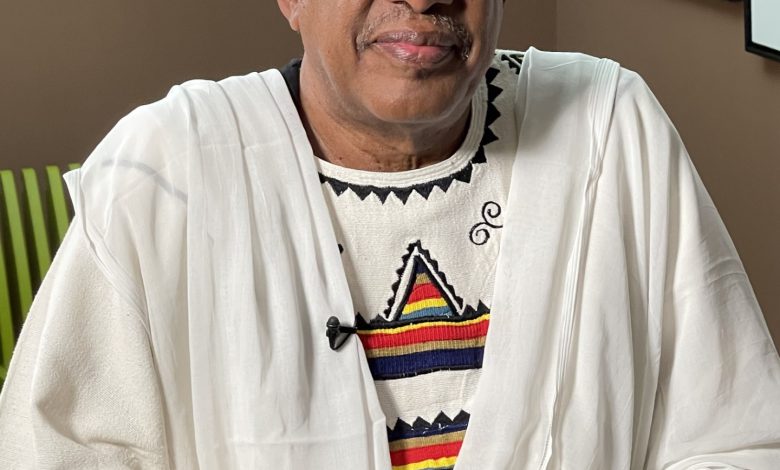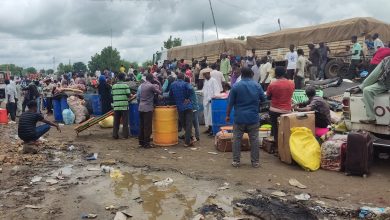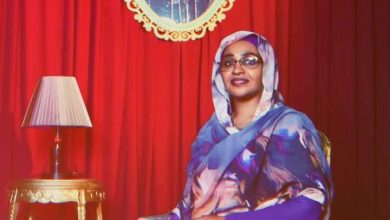Visual artist Rashid Diab in an interview with (Al-Ahdath): The war is a brutal and intentional expansion to destroy the Sudanese identity

Visual artist Rashid Diab in an interview with (Al-Ahdath):
The solution is in art
The war is a brutal and intentional expansion to destroy the Sudanese identity
Art stands firmly behind the army because it has legitimacy
Visual artist Dr. Rashid Diab said that art stands firmly behind the military institution that has the legitimacy to expel the thugs.
He confirmed in an interview with (Al-Ahdath) that the war that has been going on for a year in Sudan aims to obliterate the Sudanese identity, and pointed out that the Sudan war reflected its true value and demonstrated the importance of this country, and the world must respect its sovereignty and not try to control it politically.
Several topics on war, art, and identity were reviewed by Al-Ahdath with Rashid Diab and came up with the following conclusion:
Dialogue – Magda Hassan
Can we say that the solution is in art as a way out of Sudan’s current crisis?
First of all, do not lose hope that things will return in Sudan as they were before. As you said, the solution can be art, art, art. Rather, killing alone does not work. We must regain the sense of art, because we missed the spirit of art in the life we lived and did not find the right spirit of the world, caring for others, and equal treatment under the shadow of the existence of democracy that establishes civilized existence. Man has the right to express his opinion, and when he says his opinion, it exposes him to many problems. He is ignorant of his existence, and ignorance of existence is not only harmful but deadly.🛑 The RSF militia are ignorant of their existence as human beings who live with different dreams from another memory or they are directed involuntarily and have nothing to do with human feeling as well as adaptation to human existence. These people need a new reformulation in order to understand the value of lives and that a person must have a moral existence that is committed to his own happiness as well as to the happiness of others. These are all values found in Sudanese heritage and world heritage that must be respected.
One year after the war, how do you see things now?
After a full year of war, there is nothing to suggest that there is any hope that these confrontations will stop. They are confrontations of ignorance, stupidity, and obstinacy, an unequal confrontation between a person who is unaware and does not understand.
It cannot be understood and there is no space for the other in his thinking, and as I used to say in articles I wrote about the role of art in society and its fundamental role in a person’s re-evaluation of himself and others and of his existence and visions, an underlying sense of the secrets of knowledge and knowledge must form a phenomenon or event that is reflected in people’s lives in their fashion, food and all elements of the collective mind.
Does art promote peaceful coexistence?
Whenever there is a spread of the true image of human existence, there is an undeclared commitment to peaceful coexistence, because man creates the atmosphere that makes him live in peace through art, and art’s primary tasks are to describe the plastic image and employ the creation of spaces to implement ideas, which leads to the search for the origin in human existence and forming the identity of the people. We are people that cannot be defeated. The Sudanese people have a solid identity, and if life returns to normal and there is a role for art, Sudan will discover its identity that respects existence.
The year of war, what effect did it have on culture and arts?
After a whole year, we fight, struggle, provoke, and become cruel, but we thank God that we have someone to protect us from this ignorance, the recognized military institution. The army has a major role in protecting us, and it is supposed to bring with it logical thinking in dealing with situations. It must have a clear plan to eliminate this cancer, accompanied by awareness of cultural and resistance to ignorance, with the goal must be to expel these bastards. Sudan is full of values that must appear in our training, rehabilitation, and life.
Is there a negligence on the part of intellectuals regarding issues of peaceful coexistence and strengthening the social fabric?
Yes, there is a failure on the part of groups that carry ideas that politicians have occupied with somewhat extreme ideological conflicts and hatred emanating from racism.
What is the role of the artist in such circumstances?
The artist has a major role and is an organizer of life. His role and presence must be recognized, as there must be a clear and effective role for the Ministry of Culture in the unity of Sudan and bringing viewpoints closer together so that one culture does not overpower another, as well as standards for social harmony.
A year later… Where do the arts stand in this war?
Art stands firmly with the army because it is the institution that protects and has the ability to absorb, and war is a resistance to a brutal and absurd tide that is obliterating Sudanese culture, breaking, looting, stealing, annihilating and plundering museums. These are things intended to obliterate Sudanese identity without thinking. These people live on the margins of self-existence. The Sudan war demonstrated the importance of this country, the world must respect its sovereignty and not try to control it politically.
Does the brush draw inspiration from these circumstances, is there a war painting?
The plastic artist narrates reality and his existence in the world because of the unity between the soul and the body, morals, vision and feeling, all of which produce the plastic work, and the plastic work is linked to the meaning of life itself. The life that we see and everything we see is a formation of a creative creation composed of matter, spirit and body. If our lives are not connected to existing things, we will not have an awareness of our existential heritage.



